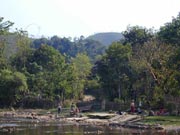 |
|
On the Merry Water-Splashing Festival |
|

|
The Dai people is a nation of the forests; but they also "migrate with waters", "travel along waters", and "live beside waters"; so it is also "a nation of water". So far as Xishuangbanna is concerned, the climate is humid, hot, and the rainfall is sufficient; the famous "Mekong River" and many of its tributaries such as Lisha River, Luosuo River and Nanla River transverses the whole territory of Xishuangbanna; so Xishuangbanna has quite sufficient water resources. However, these rivers are mostly in places lower than the places the Dai folks inhabit; and the Dai folks can only bemoan their insignificancy in the face of waters though they are good at planting rice. If they want to develop their rice production, they can only depend on water flowing out from the rain forests. Therefore, ever since the time agriculture started, the Dai folks formed the simple natural biological concept that "there won't be any water without forests". They are good at growing rice, and they also have a profound understanding that "there won't any water without forests". They seldom practice "slash-and-burn" farming, because they realize the rule of "becoming rich in three years by cutting trees, but several later generations will suffer from poverty after the forests disappear". Even when they are in need woods for the construction of houses, according to their village regulations and their belief, they will only go to designated areas to cut the trees they need. In this way, they ensure the forests can be used in ever-lasting ways. The Dai folks need large amounts of fuels for their daily life, but they will not go to the forests for fuel woods; instead, each Dai family will plant some cassia siamea trees in places nearby the village for their fuel wood. Because they have such consciousness, they developed a "forest water" irrigation system amidst the picturesque sceneries; with the help of the irrigation system, they can make use of the "forest water" with low temperature to reduce the high temperature in the scorching rice field. By doing this, they also the nutrition left by the rotten forests in the water is also absorbed by their rice plants; so, even the "sanitation rice fields" they developed in the past can also have high yields.
 |
|
Dai folks living beside water |
In the past, the highest headman of Xishuangbanna, "Zhao Pian Ling", possessed everything in this part; according to him, the mountains and rivers here all belonged to his family, and he stipulated in the laws: "farmers must use the water in the canals if they want to farm". He had a canal system and he appointed officials of all levels for the management of the water resources, and the officials were called "Ban Men". So to speak, before the 1950s, there were 12 canals in Jinghong, each canal flew across many villages, and the water supply to each village was controlled by the "Ban Men". Before planting rice each year, the canals would be dredged first; each village or community was responsible for the maintenance and dredging of the canal within their territory; the "Ban Men" would float a bamboo raft down the stream, if the raft was blocked in a place, the local villages must redo the dredging works, until his bamboo raft could get through smoothly. When allocating water, the "Ban Men" would place his bamboo water-dividing meter on the cofferdam; villages had more rice fields and needed more water have thicker bamboo barrels. The assignment of forest water for each village had marks or "holes" on the bamboo barrel, and the water would be allocated according to the amount of fields of each household. Of course, the farmers must pay the cost for using water, while the water-dividing meter was under the control of Ban Men; whoever violated the rules, he would be punished. When dividing the water, the headman of each village and the headman of the upper level must be on site for supervision. We can say that, this is a set of primitive but effective water resource management methods.
 |
|
A Village of the Dai People |
Regarding the Dai folks who live far away from large-sized flat plains, the selection of their village site has close relations with waters too. Xishuangbanna situates in the red soil and yellow soil district of the tropical and sub-tropical areas; the soil weathers seriously, and the organism become minerals very quickly; the soil grains are small and have very low organism contents; more, the soil loses seriously too. Therefore, in the rainy season from May to October each year, the river water is muddy and cannot be used as drinking water. The Dai folks usually select the place where small streams join a large river as the site of their village, and begin to cultivate in the small basins flooded by the small streams; in this way, they can make use of the water in the streams to irrigate their fields; but what is more important is that, the water in the streams are clear all the year round, even in rainy seasons, thus can be used as drinking and irrigation water. Some Dai families may introduce clear water into the terrace of each household with bamboo barrels; they began to use tap water quite early. Some other people use water as power to drive water mortars to grind their grains; and we can still see such ancient mills in Xishuangbanna today. Temperature is high in Xishuangbanna all year round; bathing is an important part of the local people's daily life. Ancient Chinese documents record that the Dai folks "take 30 baths each single day". Though this is exaggerating, we can see how frequently they bathe.


|